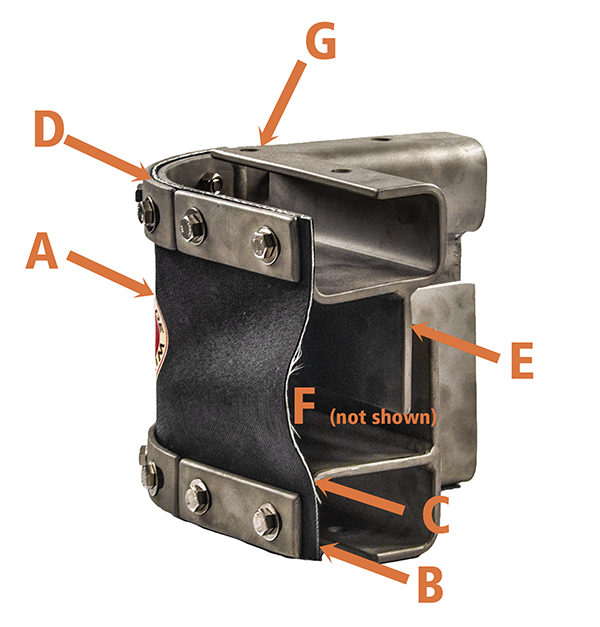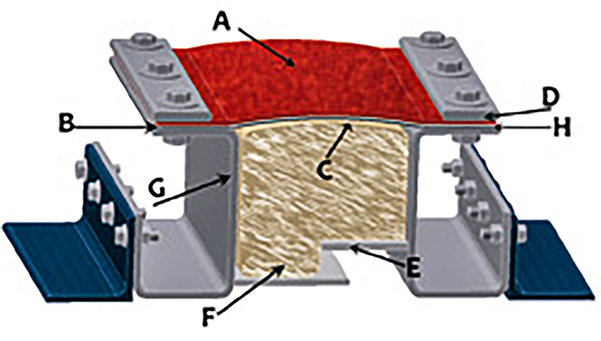Anatomy and Structure of a Fabric Expansion Joint: ThermaFlex Expansion Joints
Therma Flex expansion joints are non-metallic flue duct expansion joints or flexible connectors
which provide stress relief for piping and ducting systems by absorbing thermal growth and shock, isolating mechanical vibration, and allowing for misalignments. Here is the basic anatomy of a Therma Flex expansion joint.
A - Gas Seal Membrane
The gas seal membrane is designed to withstand system pressure and provide resistance to chemical attack from the interior and exterior. The gas seal needs to have the flexibility to absorb thermal movements. Depending on system temperature, it may require additional thermal protection.
B - Insulating Layers
The insulating layers provide a thermal barrier to ensure that the inside surface temperature of the gas seal membrane does not exceed its maximum service temperature. The insulating layer can also reduce condensation that would be caused by the gas stream if it were to come in contact with the cool surface of an uninsulated gas seal membrane.
C - Insulating Retainer Layer
This layer keeps the insulating layers in place and maintains thermal integrity. The retaining layer must be able to withstand gas stream temperatures and must be chemically compatible with system media.
D - Back Up Bars
Back up bars, positioned at the belt frame attachment, use clamping pressure to create the fabric-to-frame seal and restrain the fabric when it is subjected to the system pressure. The thickness and width of the backup bars should be sufficient to perform this function with the bolt spacing being used. The edges of the backup bars will have a radius to preclude cutting of the fabric.
E - Metal Liner or Baffle
A liner is designed to protect the gas seal membrane and insulating layers of the flexible element from abrasive particles which may be present in the gas stream. A liner is also used to reduce flutter of the fabric element caused by turbulence, to help control the accumulation of dust or ash in the expansion joint cavity, and to reduce the temperature of the flexible element.
F - Cavity Pillow
An accumulation bag is intended to deter fly ash from building up in the expansion joint cavity. It is typically used, in conjunction with a liner, in duct runs from boilers to air clean-up equipment such as precipitators, scrubbers, and bag houses, or whenever high amounts of duct or ash are present in the gas. A fly ash barrier must be capable of retaining its strength and flexibility while being exposed to maximum system temperatures and media.
G - Fabric Expansion Joint Frame
The expansion joint frame design controls the effectiveness of the connection of the flexible element to the ductwork. In some designs, they can be attached directly to the ductwork and thus eliminate the necessity for an adjoining duct flange. Frames can be designed with a “landing bar” duct attachment which allows some installation misalignment without affecting the flexible element. The frames establish the standoff height of the fabric, which is necessary to achieve thermal integrity during all movement conditions. The edges of the flanges in contact with the gas seal membrane should also have a radius to prevent damage.
H - Gasket
Single-ply fluoroplastic and fluoroelastoplastic belt designs such as Ultrachem materials require flexible chemically inert gaskets. Cuff tape can also be applied in this area to protect the belt from conducted frame heat and movement abrasion.

